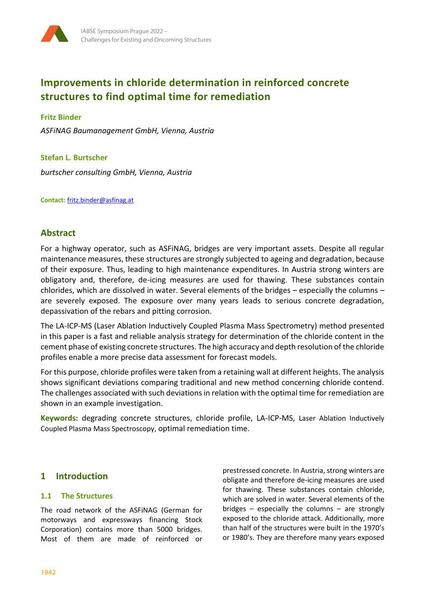Improvements in chloride determination in reinforced concrete structures to find optimal time for remediation

|
|
|||||||||||
Bibliographic Details
| Author(s): |
Fritz Binder
(ASFiNAG Baumanagement GmbH, Vienna, Austria)
Stefan L. Burtscher (burtscher consulting GmbH, Vienna, Austria) |
||||
|---|---|---|---|---|---|
| Medium: | conference paper | ||||
| Language(s): | English | ||||
| Conference: | IABSE Symposium: Challenges for Existing and Oncoming Structures, Prague, Czech Republic, 25-27 May 2022 | ||||
| Published in: | IABSE Symposium Prague 2022 | ||||
|
|||||
| Page(s): | 1942-1947 | ||||
| Total no. of pages: | 6 | ||||
| DOI: | 10.2749/prague.2022.1942 | ||||
| Abstract: |
For a highway operator, such as ASFiNAG, bridges are very important assets. Despite all regular maintenance measures, these structures are strongly subjected to ageing and degradation, because of their exposure. Thus, leading to high maintenance expenditures. In Austria strong winters are obligatory and, therefore, de-icing measures are used for thawing. These substances contain chlorides, which are dissolved in water. Several elements of the bridges – especially the columns – are severely exposed. The exposure over many years leads to serious concrete degradation, depassivation of the rebars and pitting corrosion. The LA-ICP-MS (Laser Ablation Inductively Coupled Plasma Mass Spectrometry) method presented in this paper is a fast and reliable analysis strategy for determination of the chloride content in the cement phase of existing concrete structures. The high accuracy and depth resolution of the chloride profiles enable a more precise data assessment for forecast models. For this purpose, chloride profiles were taken from a retaining wall at different heights. The analysis shows significant deviations comparing traditional and new method concerning chloride contend. The challenges associated with such deviations in relation with the optimal time for remediation are shown in an example investigation. |
||||
| Keywords: |
LA-ICP-MS chloride profile degrading concrete structures Laser Ablation Inductively Coupled Plasma Mass Spectrometry optimal remediation time
|
||||
| Copyright: | © 2022 International Association for Bridge and Structural Engineering (IABSE) | ||||
| License: | This creative work is copyrighted material and may not be used without explicit approval by the author and/or copyright owner. |
||||

